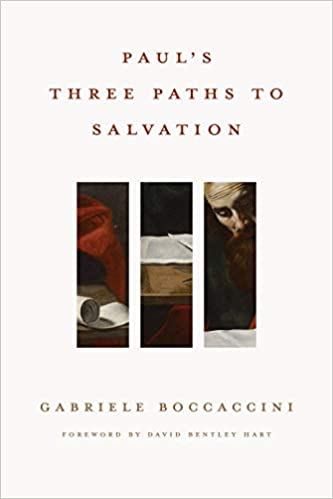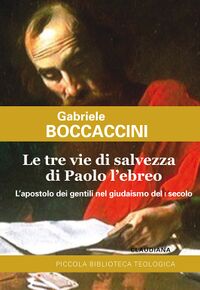File:2020 * Boccaccini.jpg
2020_*_Boccaccini.jpg (333 × 499 pixels, file size: 13 KB, MIME type: image/jpeg)
Gabriele Boccaccini, Paul's Three Paths to Salvation (Grand Rapids, MI: Eerdmans, 2020).
Translations
- {it} Le tre vie di salvezza di Paolo l'ebreo. L'apostolo dei gentili nel giudaismo del I secolo (Torino: Claudiana, 2021).
Abstract
<“We no longer need to separate Paul from Judaism in order to claim his Christianness,” writes Gabriele Boccaccini, adding, “nor do we need to separate him from the early Jesus movement in order to state his Jewishness.” With this guiding principle Boccaccini unpacks the implications of Paul’s “belonging” simultaneously to Judaism and Christianity to arrive at the surprising and provocative conclusion that there are in fact three means of salvation:
- For Jews, adherence to Torah.
- For gentiles, good works according to conscience and natural law.
- For all sinners, forgiveness through faith in Jesus Christ.
Paul’s Three Paths to Salvation is an attempt to reconcile the many facets of Paul’s complex identity while reclaiming him from accusations of intolerance, and Boccaccini’s work in reestablishing the figure of Paul as a messenger of God’s Mercy to the sinners is an important contribution to the ongoing conversation about Paul’s place in the contemporary pluralistic world.>--Publisher description.
Reviews
- Matthew V. Novenson, University of Edinburgh
“Thanks in large part to the efforts of Gabriele Boccaccini, New Testament scholarship today is busy interpreting Paul within Second Temple Judaism. The interesting work now is in the details: sorting out which features of traditional interpretations can stand and which need to be revised or jettisoned. In this fascinating book, Boccaccini threads this needle in his own inimitable way: Augustine and Luther rightly perceived Paul’s preoccupation with divine grace, but they did not comprehend the apostle’s taxonomy of Jews, gentiles, and sinners, a taxonomy at home in the ancient Jewish apocalypses. Anyone interested in the Paul-within-Judaism debates really must read this book.”
- Mark D. Nanos, University of Kansas
“Gabriele Boccaccini’s focus on the topic of ‘salvation’ in Paul’s texts arguably plays to a traditional Christian theological preoccupation, but one considered less relevant in traditional Jewish studies. However, Boccaccini’s expertise in Second Temple Jewish apocalypticism, Enochic traditions in particular, combined with a commitment to read Paul within Judaism, warrants reconsideration of the potential relevance for both Christian and Jewish research. The investigation undertaken helpfully demonstrates the wisdom of his introductory assertion: ‘The recognition [from a Paul-within-Judaism perspective] that Paul was and remained all his life a Jew and a Torah-observant Jew cannot be taken as the conclusion of our inquiry; it is only the starting point.’”
- Jörg Frey, University of Zurich
“In this very accessible book, Boccaccini opens up a fresh look on the debates on Paul. His wide knowledge of Second Temple Judaism and his focus on Enochic traditions helps to overcome the impasses of the current debate on “Paul Within Judaism.” With his provoking view that for Paul, Christ is not the only path of salvation, nor one of two different paths (for Jews and gentiles), but a third path, for sinners, Jew and gentiles alike, Boccaccini opens up a fresh angle for the discussion. He wisely avoids any ideological one-sidedness and helps to perceive the tensions in Paul’s thought.”
- Donald Senior, CP, Catholic Theological Union (in The Bible Today)
Gabriele Boccaccini, professor at the University of Michigan, is a remarkable scholar, thoroughly acquainted with Second Temple Judaism as well as with the Jesus movement reflected in the New Testament. In this brilliant and exceptionally clear work he places Paul as both a Jew within the diversity of first-century Judaism and a Christian and ardent follower of Jesus. Paul’s gospel proclaimed that salvation was accessible through fidelity to the Torah for righteous Jews, through their own conscience and the signs of God’s presence in creation for righteous Gentiles. For the unrighteous, whether Jew or Gentile, God’s forgiveness comes through Christ. When all is said and done Paul was a proclaimer of God’s mercy and forgiveness, not a herald of judgment and condemnation as some later traditions would misrepresent him.
- Isaac Oliver, Bradley University, Studies in Christian-Jewish Relations 16.1 (2021): 1-3
"As his many other insightful contributions to the study of Second Temple Judaism, Boccaccini’s treatment of Paul does not disappoint. His original interpretation of Paul’s thought in light of Enochic texts is especially welcome, as Pauline scholarship has neglected this literary corpus. By widening the spectrum of Second Temple Jewish texts, Boccaccini effectively elucidates Paul’s Jewish identity without divorcing him from his original Jewish milieu or reducing him into a Jew of “common Judaism” (to quote E. P. Sanders) who agreed with other Jews on every key point, save for the belief that Jesus had come to save the Gentiles. The most original idea of this book though may elicit controversy. Some readers might wonder to what degree, if any, Paul would have divided humanity into the three categories (i.e., righteous Jews, righteous Gentiles, and sinful Jews and Gentiles) that Boccaccini discerns in the Book of Parables and the Synoptics. This proposal, however, requires the most serious consideration, seeing how Paul’s letters—along with the rest of the New Testament—have been interpreted to condemn, indeed eternally damn, Jews (and non-Jews) who do not confess Jesus. It is hoped therefore that Boccaccini’s book will reach the widest readership possible. It will challenge convictions that are assertively exclusivistic while empowering those seeking to construct a more considerate hermeneutic that is historically grounded.
External links
- [ Google Books]
File history
Click on a date/time to view the file as it appeared at that time.
| Date/Time | Thumbnail | Dimensions | User | Comment | |
|---|---|---|---|---|---|
| current | 11:59, 12 May 2020 |  | 333 × 499 (13 KB) | Gabriele Boccaccini (talk | contribs) |
You cannot overwrite this file.
File usage
The following 2 pages use this file:

